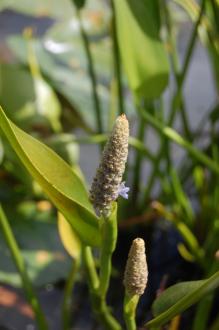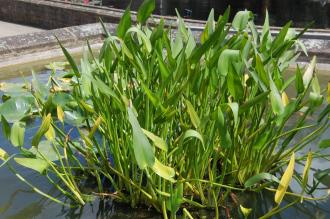
Pontederia cordata Flower Bud (30/06/2012, Kew Gardens, London)
Position: Full sun to light shade
Flowering period: Summer
Soil: Wet, poorly drained (to a depth of 30cm of water)
Eventual Height: 90cm
Eventual Spread: 60cm
Hardiness: 3a – 9b
Family: Pontederiaceae
Pontederia cordata is a low growing, deciduous, perennial, emergent aquatic plant. Its light green leaf shape is variable, being lanceolate, oval to spear shaped with entire margins, waxy and up to 40cm long and 15cm broad. Its stems take oxygen to its roots and is tolerant of low soil oxygen. Its blue/ purple flowers have yellow markings, are variable in form and appear on erect spikes which are up to 15cm long. Once the plant begins to produce seed its stem bends and submerges the seeds. Its roots are rhizomes which aids the spread of this plant.
Pontederia cordata, commonly known as Pickerelweed, Heart-leaved Pickerel Weed or Pickerel Weed, is native to North America and South America. In its native habitat it grows in slow moving or stagnant water at pond and lake margins and swamps. It is tolerant of fluctuating water levels. It is invasive plant in a number of locations around the world and we would recommend you check to see if it is invasive in your area before planting it in locations which might discharge parts of this plant into watercourses.
The etymological root of the binomial name Pontederia is named after Giulio Pontedera (1688 – 1757), professor of botany at Padua, Italy. Cordata is derived from the Latin cordis meaning ‘heart’, in reference to the leaf shape.

Pontederia cordata (30/06/2012, Kew Gardens, London)
The landscape architect may find Pontederia cordata useful at pond and lake margins to protect against water buffering.
Ecologically, P. cordata is attractive to pollinating insects. It provides an egg laying site for adult Dragonfly. Some water foul and mammals will consume its leaves. Fish will utilize its leaves for cover.
The Royal Horticultural Society has given P. cordata their prestigious Award of Garden Merit in 1993.
P. cordata prefers wet, fertile. It tolerates most pH of soil. It will tolerate soils with low oxygen levels. It prefers a water depth of up to 30cm.
Pontederia cordata requires little maintenance. Large clumps may be divided in spring.

